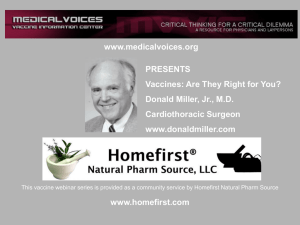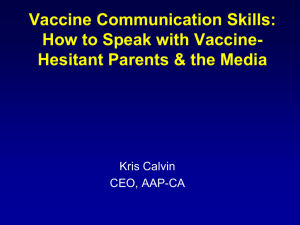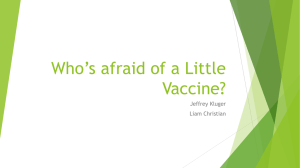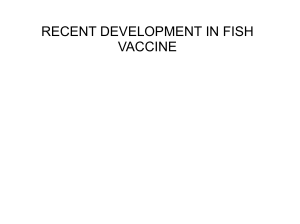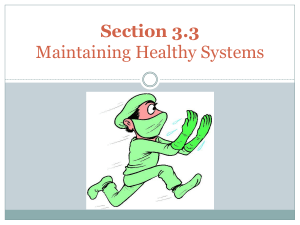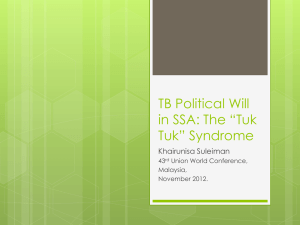Document
advertisement
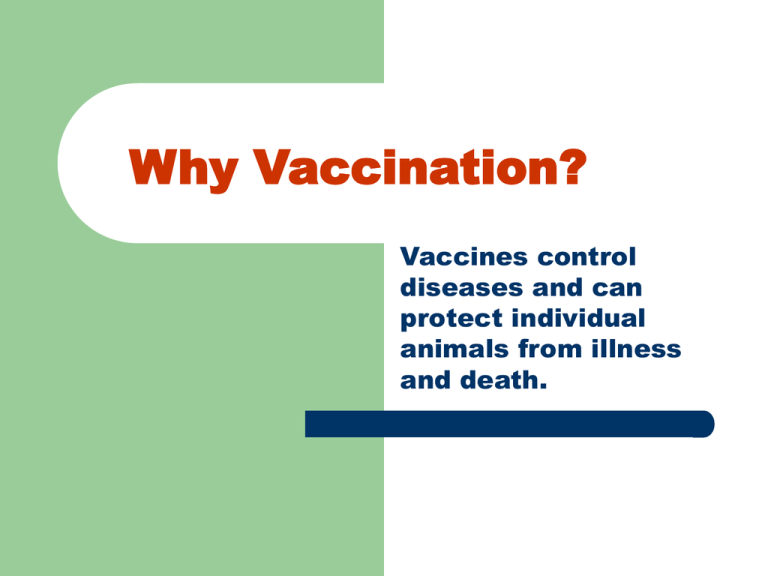
Why Vaccination? Vaccines control diseases and can protect individual animals from illness and death. Outline of Presentation What vaccines do How vaccines work Dog and cat vaccination What Vaccines do: Increase Resistance to Infection There are many ways to improve general health: Proper nutrition, Exercise, Healthy lifestyle, and… Vaccination! Healthy Lifestyle--The Best Way to Prevent Disease! Eating healthy food, taking vitamins, and regular exercise stimulates the immune system. Good sanitation such as washing your hands also limits an infectious agent’s ability to spread to you and others. Vaccinations help both you and your best friend stay safe. Why Is Vaccination Important Protect everyone who is vaccinated Target specific diseases Stop epidemics Goals of Vaccination Vaccinate the largest possible number of individuals in the population at risk. Vaccinate each individual no more frequently than necessary. Vaccinate only against infectious agents to which individuals have a realistic risk of exposure and subsequent development of disease. Vaccines Vaccines consist of killed or weakened microbes that stimulate the immune system so it will be prepared to defend your body against these diseases. How Vaccines Are Made Microbes grown on suitable medium Purified to remove compounds that could cause allergic reactions (not always possible) Review Quiz What Vaccines Are 1. 2. 3. 4. 5. What are two main ways to improve resistance to infection? Why is vaccination important? What should the goals of vaccination be? What is a vaccine? How are vaccines made? How Vaccines Work ? How Vaccines Work Vaccines usually stimulate the immune system to recognize the infectious agent and to produce antibodies to the disease. If the immunized animal is later exposed to the infectious agent, the antibody-producing cells “remember” their earlier encounter with the infectious agent and respond quickly to make more antibodies. So what’s an antibody? An antibody is a protein (called immunoglobulin) that can destroy infectious microbes by making it more easy for white blood cells to capture and destroy the microbes. How Antibodies Work 1. Microbes such as bacteria invade the body 3. Antibodies send signals to attract the White Blood Cells, the defending cells in the body. 2. Antibodies recognize the invaders and attach to the microbes 4. White Blood Cells come and destroy the invading microbes Different Types of Vaccines Weakened (Modified Live) Vaccine Inactivated (Killed) Vaccine Toxoid Vaccine Subunit Vaccine Weakened (Modified Live) Vaccines Produced by weakening a live vaccine or removing it’s disease-causing ability. Pros - They emit a large immune system response so you only have to receive the vaccine once or twice. Cons - They have to be kept in special conditions, like refrigeration. - They can mutate and might cause the disease. Inactivated (killed) Vaccines These vaccines are produced by killing the infectious agent. Pros Cons - They do not have to be refrigerated. - They usually require booster shots because they only weakly stimulate the immune system to make antibodies. - They will never come back to life and cause the disease. Toxoids Toxoids made by inactivating the toxin that some infectious agents create. Toxoids used against Tetanus and Diphtheria. Pros - You only have to have the vaccine once or twice. - They will never be reactivated and cause the disease. Cons - They have to be refrigerated. Subunit Vaccines Made by taking apart an infectious agent and only using the antigenic part (the part that stimulates an immune response). Example vaccines: Hepatitis B and Streptococcus pneumoniae Pros - They cannot cause the disease. Cons - They are more difficult to make and require new, expensive technology. Time to Produce Protection Vaccines do not stimulate immunity immediately after they are given. It takes 5-14 days for the immune system to respond and remember the agents that are introduced. In some instances, two or more vaccinations several weeks apart must be given to achieve protection. Review Quiz 1. 2. 3. How do vaccines work? What are antibodies and what do they do? What are the different types of vaccines? Vaccination for Dogs & Cats Vaccines are Life Saving Vaccines have saved the lives of millions of dogs and cats by protecting them against diseases. Before the days of effective vaccines, dogs routinely died from distemper, hepatitis, leptospirosis, parvovirus and complications of upper respiratory infections such as kennel cough. Importance of Physical Exam Pets need to be healthy to receive vaccination. Sick animals do not respond well to vaccination. Veterinarians provide health and nutrition information that you can’t get from pet stores. Pets that visit the veterinarian once a year are healthier, happier, and live longer. Tailored Vaccination Program Not every dog or cat needs the same set of vaccinations. Pet owners should work with their veterinarians to design a vaccination schedule for each pet based on age, health status, reproductive status, and environment. Vaccination: Balancing the Risks Even vaccines that have been proven to be safe and effective in most animals may cause adverse reactions to a small group of animals. However, vaccines have greatly reduced the incidence of diseases in many countries, protecting the health of many animals. Also, by vaccinating animals against diseases that are zoonotic (transmissible between animals and humans), we are protecting people as well. Vaccine Example: Rabies Rabies vaccine causes adverse reactions in 1 out of 60,000 dogs. In the United States, rabies in domestic animals (like dogs, cats, and cattle) has declined dramatically since the 1950s. This decrease is mainly due to rabies vaccinations. The benefits of giving rabies vaccines for protection against disease far outweigh the risks of occurrence of adverse reactions. Adverse Reactions to Vaccines Vaccine reactions are uncommon, but they are important to watch out for because some of these rare reactions can be fatal. It is recommended that your pets be monitored for vaccine reactions for 24 hours following vaccinations. Anaphylaxis Anaphylaxis is a rare, life-threatening, immediate allergic reaction. The most common symptoms are the sudden onset of diarrhea, vomiting, seizures, coma, and shock. The animals' gums will be very pale, and the limbs will feel cold. If this occurs, take your pet to the nearest veterinary clinic or emergency animal hospital immediately. Adverse Reactions to Vaccines (continued) Pain, swelling, redness, and irritation can occur at the injection site. Mild fever, decreased appetite, and depression may also occur. If you notice any of these signs in your pets, contact your veterinarian immediately. Although all these reactions sound scary, compared to the risks of not vaccinating dogs and cats, the risks associated with vaccinations are very small in comparison. Review Quiz Why is physical exams by veterinarians important to your pets? Why are we not giving the same vaccines to every animal? What are the risks of vaccination, and why do we still vaccinate if there are risks? What are some adverse reactions of vaccination? References & Further Readings Cat Vaccines: http://www.catvaccines.com/ UC Davis VMTH Canine and Feline Vaccination Guidelines: http://www.vmth.ucdavis.edu/vmth/clientinfo/info/genmed/vaccin proto.html AAHA Vaccine Guidelines: http://www.aahanet.org/PublicDocuments/VaccineGuidelines06 Revised.pdf HealthyPet.com http://www.healthypet.com/library_view.aspx?ID=196&sid=1
